Crystal Structures, Hirshfeld Surfaces, and Thermal Study of Isostructural Polymeric Ladders of La(III) and Sm(III) Coordination Compounds with 4,4’-Bipyridine and Dibromoacetates
Abstract
1. Introduction
2. Materials and Methods
2.1. Materials
2.2. Methods
3. Results and Discussion
3.1. Thermal Study
3.2. TG-MS Spectra
3.3. Crystal Structure Determination
3.4. Hirshfeld Surface Analysis
4. Conclusions
Supplementary Materials
Author Contributions
Funding
Conflicts of Interest
References
- Dutta, B.; Jana, R.; Bhanja, A.K.; Ray, P.P.; Sinha, C.; Mir, M.H. Supramolecular Aggregate of Cadmium(II)-Based One-Dimensional Coordination Polymer for Device Fabrication and Sensor Application. Inorg. Chem. 2019, 58, 2686–2694. [Google Scholar] [CrossRef]
- Wang, S.; Liu, J.; Zhao, H.; Guo, Z.; Xing, H.; Gao, Y. Electrically Conductive Coordination Polymer for Highly Selective Chemiresistive Sensing of Volatile Amines. Inorg. Chem. 2018, 57, 541–544. [Google Scholar] [CrossRef] [PubMed]
- Tan, H.; Ma, C.; Song, Y.; Xu, F.; Chen, S.; Wang, L. Determination of tetracycline in milk by using nucleotide/lanthanide coordination polymer-based ternary complex. Biosens. Bioelectron. 2013, 50, 447–452. [Google Scholar] [CrossRef] [PubMed]
- Gu, T.-Y.; Dai, M.; Young, D.J.; Ren, Z.G.; Lang, J.P. Correction to Luminescent Zn(II) Coordination Polymers for Highly Selective Sensing of Cr(III) and Cr(VI) in Water. Inorg. Chem. 2017, 56, 11450. [Google Scholar] [CrossRef]
- Guo, X.-Z.; Chen, S.-S.; Li, W.-D.; Han, S.-S.; Deng, F.; Qiao, R.; Zhao, Y. Series of Cadmium(II) Coordination Polymers Based on a Versatile Multi-N-Donor Tecton or Mixed Carboxylate Ligands: Synthesis, Structure, and Selectively Sensing Property. ACS Omega 2019, 4, 11540–11553. [Google Scholar] [CrossRef]
- Zhang, Y.-Q.; Blatov, V.A.; Zheng, T.-R.; Yang, C.-H.; Qian, L.-L.; Li, K.; Li, B.-L.; Wu, B. A luminescent zinc(II) coordination polymer with unusual (3,4,4)-coordinated self-catenated 3D network for selective detection of nitroaromatics and ferric and chromate ions: A versatile luminescent sensor. Dalton Trans. 2018, 47, 6189–6198. [Google Scholar] [CrossRef]
- Cui, J.-W.; Hou, S.-X.; Li, Y.-H.; Cui, G.-H. A multifunctional Ni(II) coordination polymer: Synthesis, crystal structure and applications as a luminescent sensor, electrochemical probe, and photocatalyst. Dalton Trans. 2017, 46, 16911–16924. [Google Scholar] [CrossRef]
- Liu, Y.; Ma, J.; Xu, C.; Yang, Y.; Xia, M.; Jiang, H.; Liu, W. A water-stable lanthanide coordination polymer as a multiresponsive luminescent sensor for Fe3+, Cr(vi) and 4-nitrophenol. Dalton Trans. 2018, 47, 13543–13549. [Google Scholar] [CrossRef]
- Hassanein, K.; Cappuccino, C.; Amo-Ochoa, P.; López-Molina, J.; Maini, L.; Bandini, E.; Ventura, B. Multifunctional coordination polymers based on copper(I) and mercaptonicotinic ligands: Synthesis, and structural, optical and electrical characterization. Dalton Trans. 2020, 49, 10545–10553. [Google Scholar] [CrossRef]
- Dey, S.; Sil, S.; Dutta, B.; Naskar, K.; Maity, S.; Ray, P.P.; Sinha, C. Designing of Pb(II)-Based Novel Coordination Polymers (CPs): Structural Elucidation and Optoelectronic Application. ACS Omega 2019, 4, 19959–19968. [Google Scholar] [CrossRef]
- Hu, X.; Zhu, H.; Sang, X.; Wang, D. Design and Synthesis of Zirconium-Containing Coordination Polymer Based on Unsymmetric Indolyl Dicarboxylic Acid and Catalytic Application on Borrowing Hydrogen Reaction. Adv. Synth. Catal. 2018, 360, 4293–4300. [Google Scholar] [CrossRef]
- Wen, T.; Zhang, D.-X.; Zhang, J. Two-Dimensional Copper(I) Coordination Polymer Materials as Photocatalysts for the Degradation of Organic Dyes. Inorg. Chem. 2013, 52, 12–14. [Google Scholar] [CrossRef]
- Wang, X.; Liu, M.; Wang, Y.; Fan, H.; Wu, J.; Huang, C.; Hou, H. Cu(I) Coordination Polymers as the Green Heterogeneous Catalysts for Direct C–H Bonds Activation of Arylalkanes to Ketones in Water with Spatial Confinement Effect. Inorg. Chem. 2017, 56, 13329–13336. [Google Scholar] [CrossRef]
- Ji, Z.-X.; Li, P.-F. Crystal Structure and Catalytic Activity of A Novel Cd(II) Coordination Polymer Formed by Dicarboxylic Ligand. Bull. Chem. React. Eng. Catal. 2018, 13, 220–226. [Google Scholar] [CrossRef]
- Hua, W.-L.; Lei, L.; Xin, W. Synthesis, Structural Characterization and Catalytic Activity of A Cu(II) Coordination Polymer Constructed from 1,4-Phenylenediacetic Acid and 2,2′-Bipyridine. Bull. Chem. React. Eng. Catal. 2017, 12, 113–118. [Google Scholar] [CrossRef]
- Jiao, L.; Sun, S.; Meng, X.; Ji, P. Sn-Based Porous Coordination Polymer Synthesized with Two Ligands for Tandem Catalysis Producing 5-Hydroxymethylfurfural. Catalysts 2019, 9, 739. [Google Scholar] [CrossRef]
- Tella, A.C.; Olawale, M.D.; Obaleye, J.A.; Adimula, V.O.; Alimil, L.O.; Ajibade, P.A. Removal of organic pollutant (pyrene) from aqueous solution using coordination polymer of [Cu(Pic)2(H2O)2]·H2O (CP-1) as adsorbent. Appl. Water Sci. 2019, 9, 159. [Google Scholar] [CrossRef]
- Dzhardimalieva, G.I.; Baimuratova, R.K.; Knerelman, E.I.; Davydova, G.I.; Kudaibergenov, S.E.; Kharissova, O.V.; Zhinzhilo, V.A.; Uflyand, I.E. Synthesis of Copper(II) Trimesinate Coordination Polymer and Its Use as a Sorbent for Organic Dyes and a Precursor for Nanostructured Material. Polymers 2020, 12, 1024. [Google Scholar] [CrossRef]
- Liang, C.; Ren, J.; Hankari, S.E.; Huo, J. Aqueous Synthesis of a Mesoporous Zr-Based Coordination Polymer for Removal of Organic Dyes. ACS Omega 2020, 5, 603–609. [Google Scholar] [CrossRef] [PubMed]
- Agarwal, R.A. One Dimensional Coordination Polymer of Zn(II) for Developing Multifunctional Nanoparticles. Sci. Rep. 2017, 7, 13212. [Google Scholar] [CrossRef]
- Czylkowska, A.; Szczesio, M.; Pietrzak, A.; Raducka, A.; Rogalewicz, B. Novel Coordination Polymer of Cadmium (II) with L-Tryptophan. Materials 2020, 13, 2266. [Google Scholar] [CrossRef] [PubMed]
- Li, C.P.; Zhou, H.; Chen, J.; Wang, J.-J.; Du, M.; Zhou, W. A Highly Efficient Coordination Polymer for Selective Trapping and Sensing of Perrhenate/Pertechnetate. ACS Appl. Mater. Interfaces 2020, 12, 15246–15254. [Google Scholar] [CrossRef] [PubMed]
- Wu, P.; Li, Y.; Zheng, J.-J.; Hosono, N.; Otake, K.; Wang, J.; Liu, Y.; Xia, L.; Jiang, M.; Sakaki, S.; et al. Carbon dioxide capture and efficient fixation in a dynamic porous coordination polymer. Nat. Commun. 2019, 10, 4362. [Google Scholar] [CrossRef] [PubMed]
- Novio, F. Design of Targeted Nanostructured Coordination Polymers (NCPs) for Cancer Therapy. Molecules 2020, 25, 3449. [Google Scholar] [CrossRef] [PubMed]
- Dhankhar, S.S.; Nagaraja, C.M. Construction of highly water-stable fluorinated 2D coordination polymers with various N, N′-donors: Syntheses, crystal structures and photoluminescence properties. J. Solid State Chem. 2020, 290, 121560. [Google Scholar] [CrossRef]
- Zhang, J.W.; Wang, C.R.; Liu, W.H.; Xu, S.; Liu, B.Q. Two kinds of 2,4-dichlorobenzoate-based lanthanide coordination polymers tuned by 4,4′-bipyridine: Syntheses, structures, photoluminescence, and magnetism. Inorg. Chim. Acta 2020, 508, 119648. [Google Scholar] [CrossRef]
- Liu, H.; Fan, Y.; Li, X.; Gao, K.; Li, H.; Yang, Y.; Meng, X.; Wu, J.; Hou, H. Photochromism of metal–organic frameworks based on carbazole-dicarboxylic acid and bipyridine: Sensing adjustment by controlling strut-to-strut energy transfer. Dalton Trans. 2020, 49, 7952–7958. [Google Scholar] [CrossRef]
- Guo, P.; Liu, M.; Shi, L. A Zn-based coordination polymer as a luminescent sensor for simple and sensitive detecting of sulfonamides antibiotics and nitroaromatic. J. Solid State Chem. 2020, 286, 121247. [Google Scholar] [CrossRef]
- Chu, H.-Y.; Fu, H.; Liu, A.; Wang, P.; Cao, Y.-L.; Du, A.-F.; Wang, C.-C. Two silver-based coordination polymers constructed from organic carboxylate acids and 4, 4′-bipyridine-like bidentate ligands: Synthesis, structure, and antimicrobial performances. Polyhedron 2020, 188, 114684. [Google Scholar] [CrossRef]
- Joshi, A.; Gupta, R.; Singh, B.; Sharma, D.; Singh, M. Effective inhibitory activity against MCF-7, A549 and HepG2 cancer cells by a phosphomolybdate based hybrid solid. Dalton Trans. 2020, 49, 7069–7077. [Google Scholar] [CrossRef]
- Islah-u-din; Chong, S.V.; Jameson, G.B.; Raymond, S.G.; Lee, G.; Park, I.K.; Wang, X.; Waterland, M.R.; Tallon, J.L. A new class of ferromagnetic semiconductor: Copper molybdate organic-inorganic compound with phenanthroline organic linkers. J. Magn. Magn. Mater. 2020, 508, 166881. [Google Scholar] [CrossRef]
- Zhu, B.; Zong, Z.; Zhang, X.; Zhang, D.; Cui, L.; Bi, C.; Fan, Y. Highly Selective and Stable Zn (II)-Based Metal–Organic Frameworks for the Detections of Tetracycline Antibiotic and Acetone in Aqueous System. Appl. Organomet. Chem. 2020, 34, 5518. [Google Scholar] [CrossRef]
- Gu, J.-L.; Tao, X.-W.; Tu, Q.-Q.; Cheng, A.L.; Gao, E.Q. Two sulfone-functionalized Zn(II)-coordination polymers as luminescent sensors for sensitive and rapid detection of nitrofurans antibiotics. J. Solid State Chem. 2020, 286, 121318. [Google Scholar] [CrossRef]
- Dana, F.; Soleimannejad, J.; Moghzi, F.; Taherzade, S.D.; Janczak, J. A new stable and reusable nanoscale Cu(II) coordination polymer as an efficient dye adsorbent. Inorg. Chim. Acta 2020, 509, 119716. [Google Scholar] [CrossRef]
- Wang, J.; Zha, Q.; Qin, G.; Ni, Y. A novel Zn(II)-based metal-organic framework as a high selective and sensitive sensor for fluorescent detections of aromatic nitrophenols and antibiotic metronidazole. Talanta 2020, 211, 120742. [Google Scholar] [CrossRef] [PubMed]
- Sieron, L.; Czylkowska, A.; Rogalewicz, B. Crystal structure of a one-dimensional coordination polymer of gadolinium dibromoacetate with 4,4’-bipyridine. Eur. J. Chem. 2018, 9, 178–181. [Google Scholar] [CrossRef]
- Czylkowska, A.; Kruszynski, R.; Czakis-Sulikowska, D.; Markiewicz, M. Coordination polymer of lanthanum: Synthesis, properties and crystal structure of [La(4,4′-bipyridine)(CCl2HCOO)3(H2O)]n. J. Coord. Chem. 2007, 60, 2659–2669. [Google Scholar] [CrossRef]
- Kruszynski, R.; Czylkowska, A.; Czakis-Sulikowska, D. A novel carboxylic coordination polymer of samarium(III): [Sm(H2O)(4,4′-bipyridine)(CCl2HCOO)3]n. J. Coord. Chem. 2006, 59, 681–690. [Google Scholar] [CrossRef]
- Czylkowska, A.; Markiewicz, M. Synthesis, thermal behavior, and other properties of Y(III) and La(III) complexes with 4,4′-bipyridine and trichloro-or dibromoacetates. J. Therm. Anal. Calorim. 2013, 114, 989–995. [Google Scholar] [CrossRef]
- Czylkowska, A. Synthesis and some properties of light lanthanide complexes with 4,4′-bipyridine and dibromoacetates: Thermal study. J. Therm. Anal. Calorim. 2012, 109, 727–734. [Google Scholar] [CrossRef]
- Sheldrick, G.M. A short history of SHELX. Acta Crystallogr. Sect. A Found. Crystallogr. 2007, 64, 112–122. [Google Scholar] [CrossRef] [PubMed]
- Sheldrick, G.M. Crystal structure refinement with SHELXL. Acta Crystallogr. Sect. C Struct. Chem. 2015, 71, 3–8. [Google Scholar] [CrossRef] [PubMed]
- Turner, M.J.; McKinnon, J.J.; Wolff, S.K.; Grimwood, D.J.; Spackman, P.R.; Jayatilaka, D.; Spackman, M.A. CrystalExplorer17; University of Western Australia: Crawley, Australia, 2017. [Google Scholar]
- Spackman, M.A.; Jayatilaka, D. Hirshfeld surface analysis. CrystEngComm 2009, 11, 19–32. [Google Scholar] [CrossRef]
- Jelsch, C.; Ejsmont, K.; Huder, L. The enrichment ratio of atomic contacts in crystals, an indicator derived from the Hirshfeld surface analysis. IUCrJ 2014, 1, 119–128. [Google Scholar] [CrossRef]
- Fábián, L.; Kálmán, A. Volumetric measure of isostructurality. Acta Cryst. 1999, B55, 1099–1108. [Google Scholar] [CrossRef]
- Bernstein, J.; Davis, R.E.; Shimoni, L.; Chang, N.-L. Patterns in Hydrogen Bonding: Functionality and Graph Set Analysis in Crystals. Angew. Chem. Int. Ed. 1995, 34, 1555–1573. [Google Scholar] [CrossRef]
- McKinnon, J.J.; Jayatilaka, D.; Spackman, M.A. Towards quantitative analysis of intermolecular interactions with Hirshfeld surfaces. Chem. Commun. 2007, 37, 3814–3816. [Google Scholar] [CrossRef]
- Spackman, M.A.; McKinnon, J.J. Fingerprinting intermolecular interactions in molecular crystals. CrystEngComm 2002, 4, 378–392. [Google Scholar] [CrossRef]
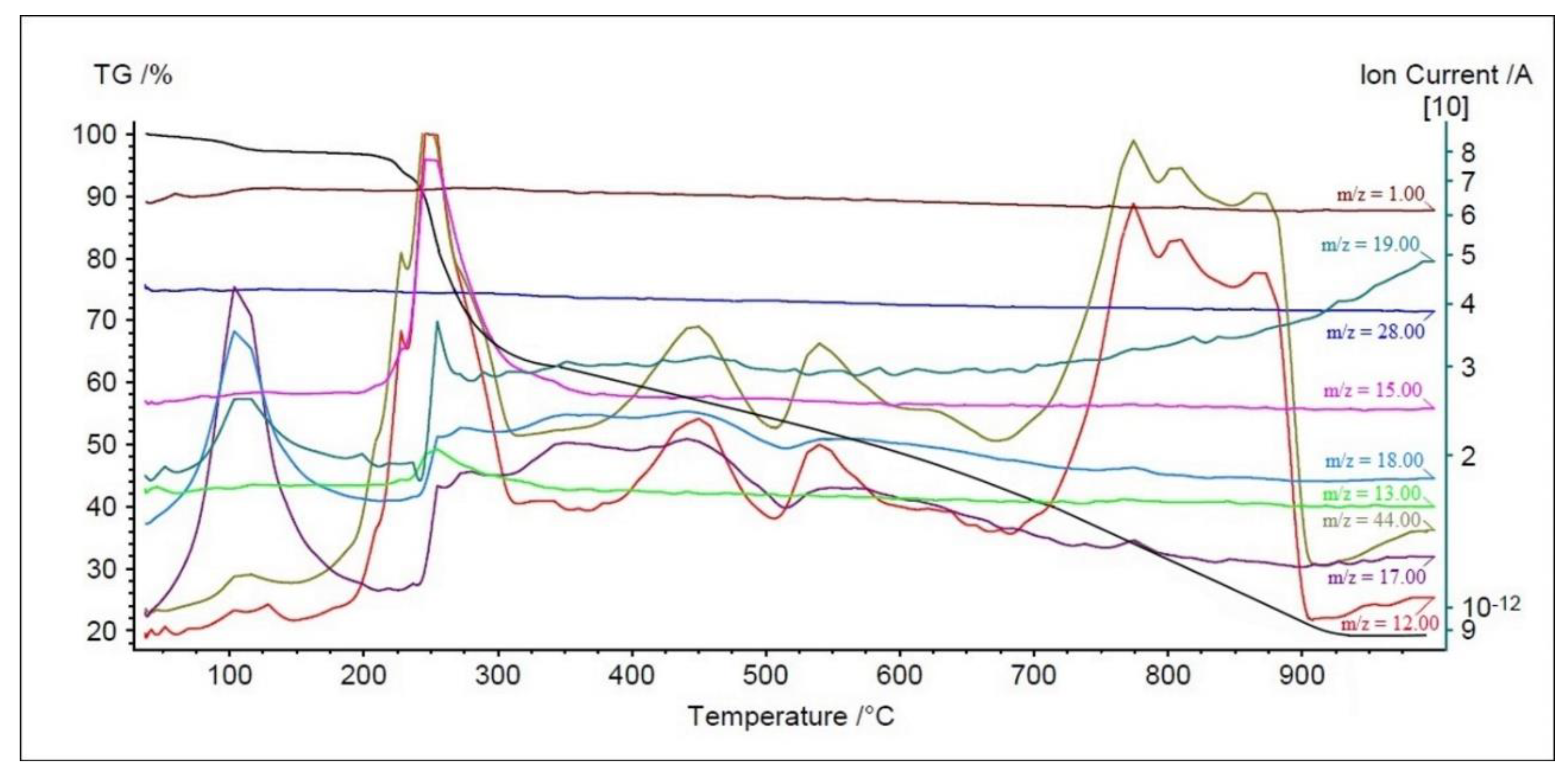
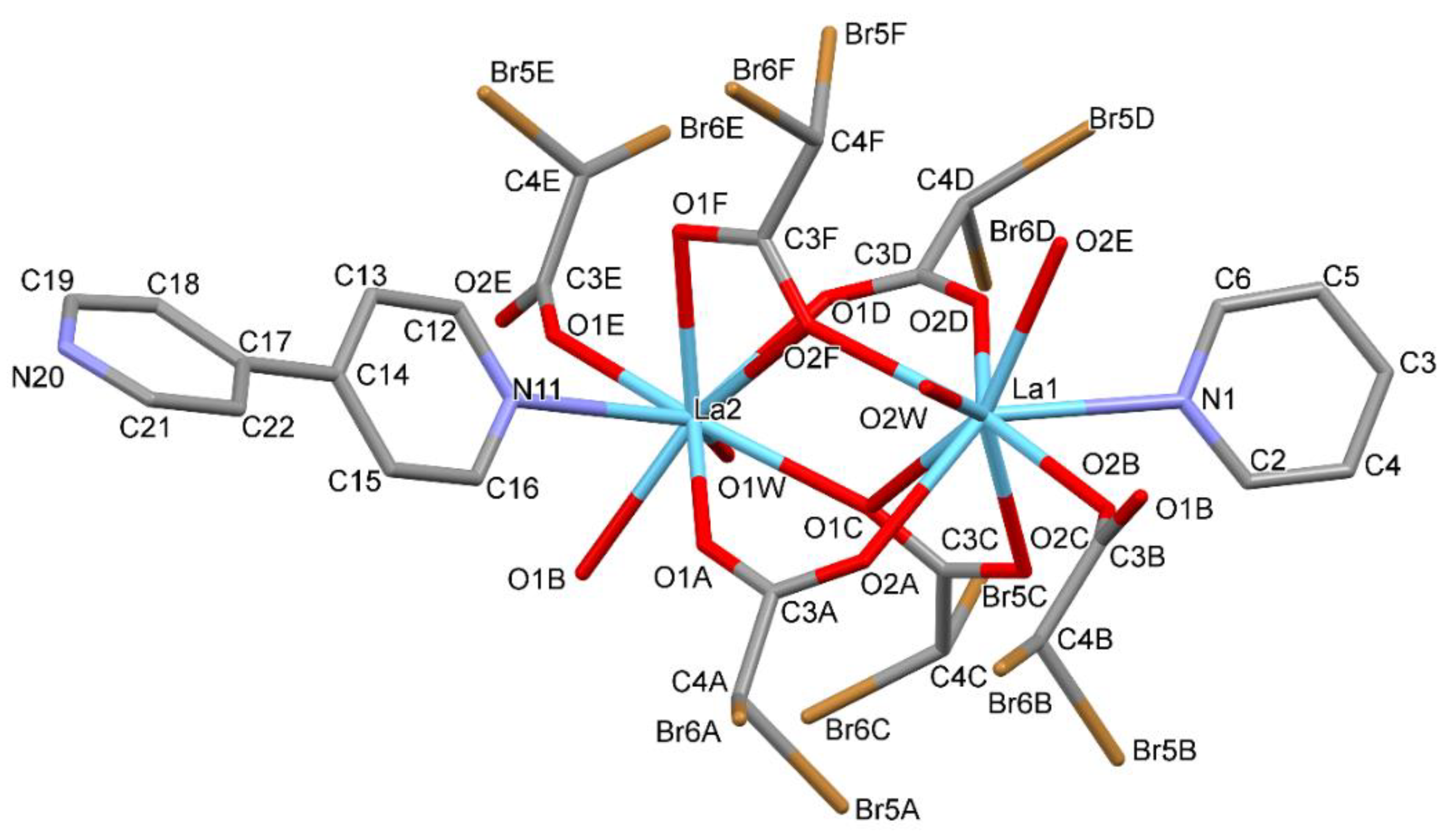
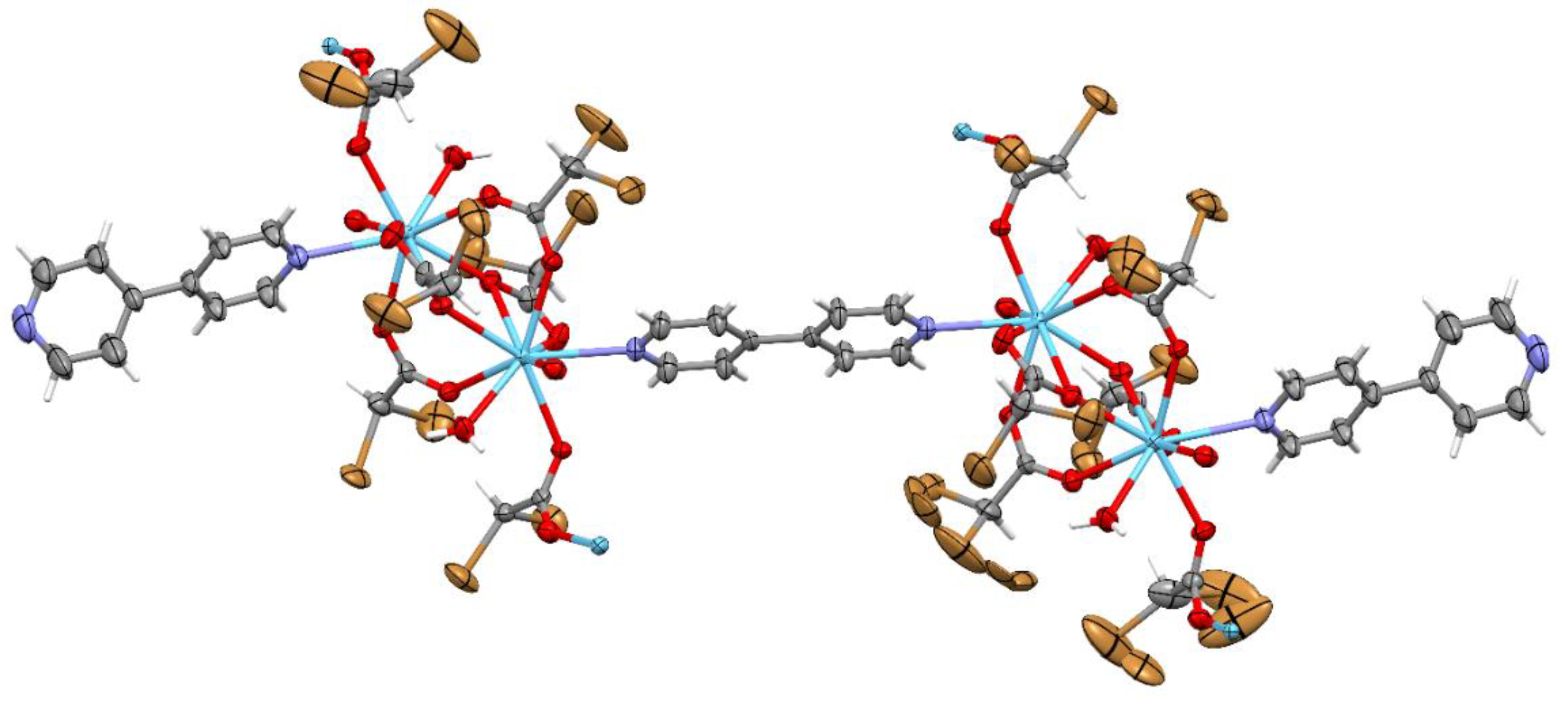
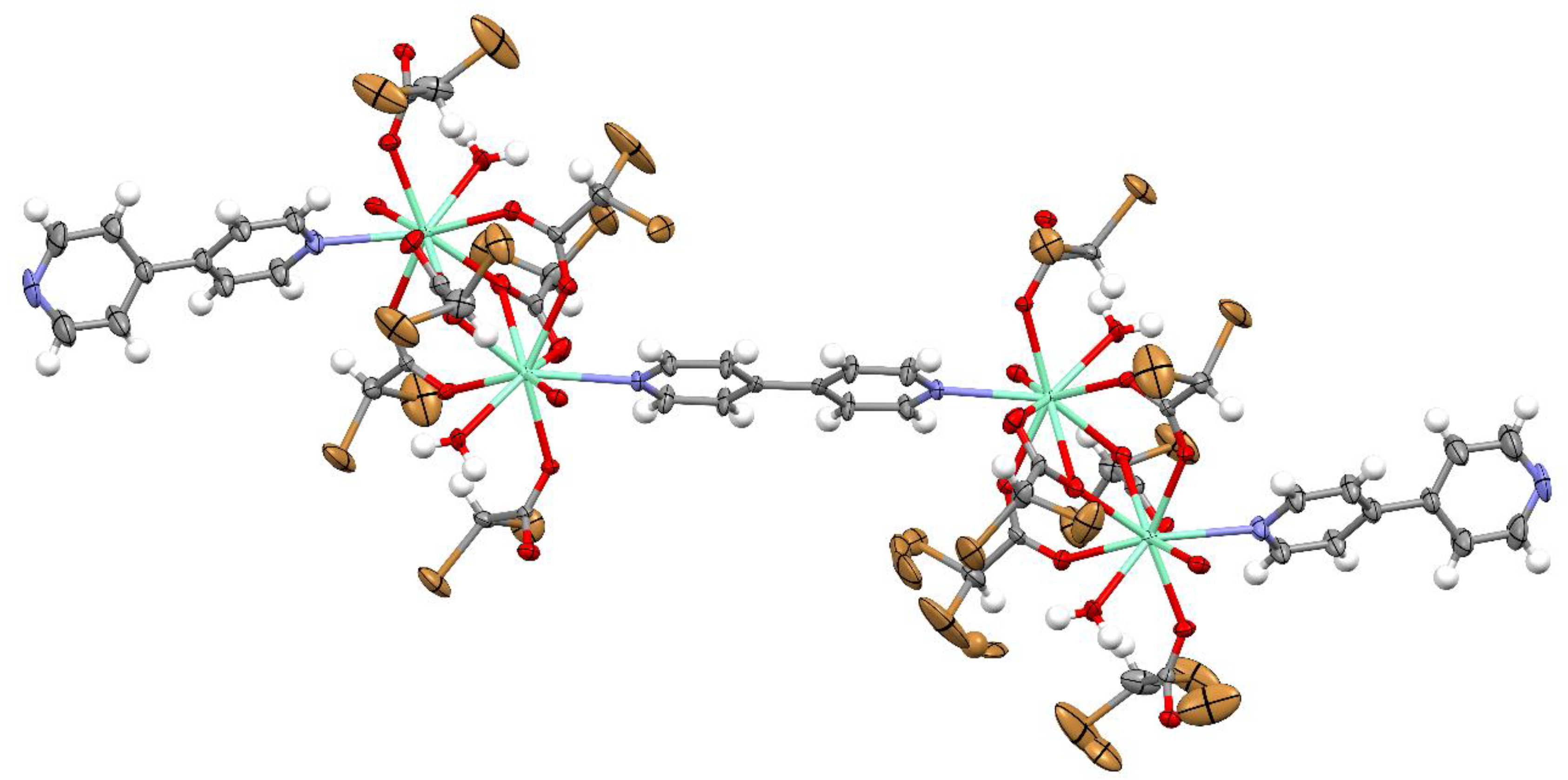
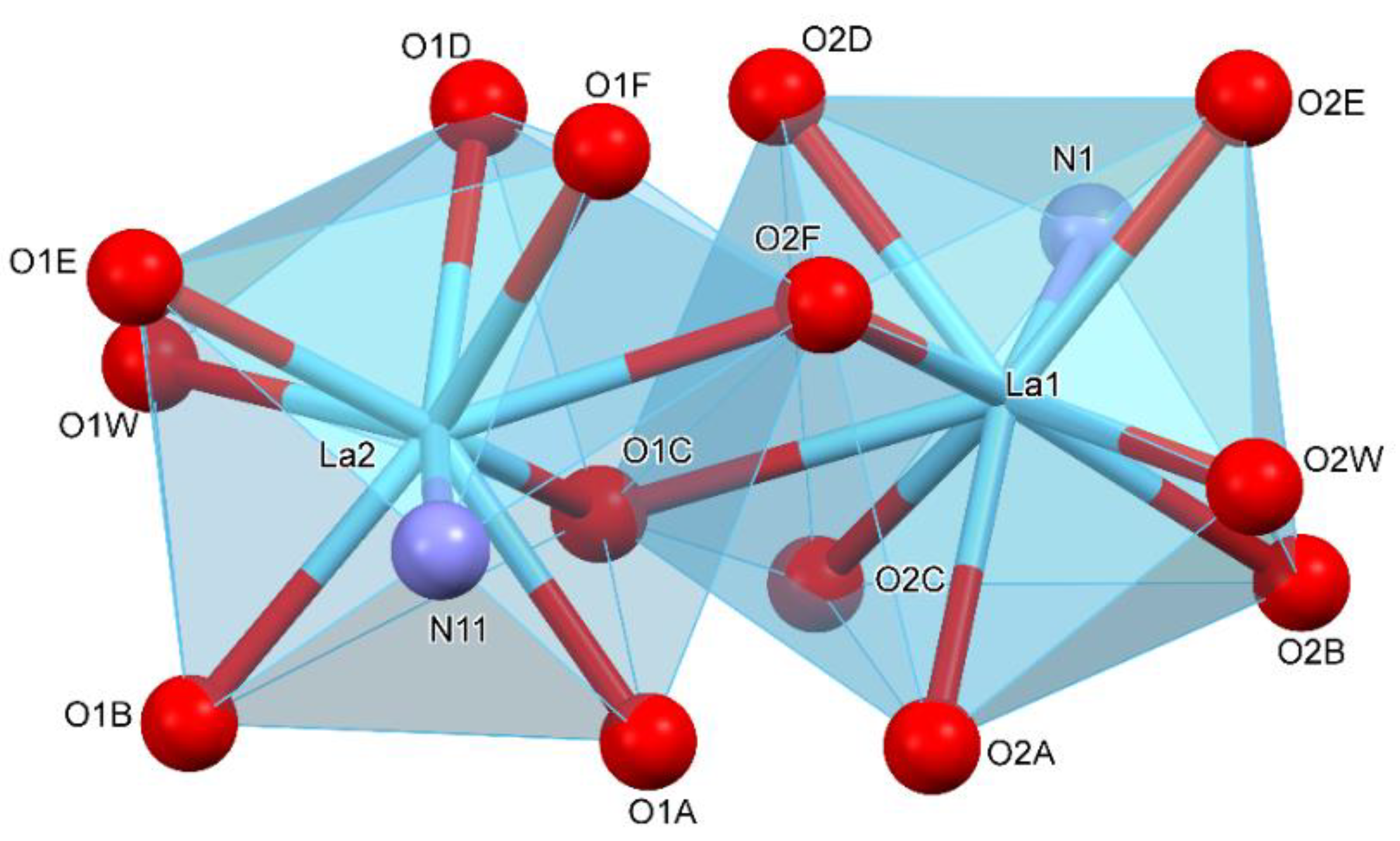
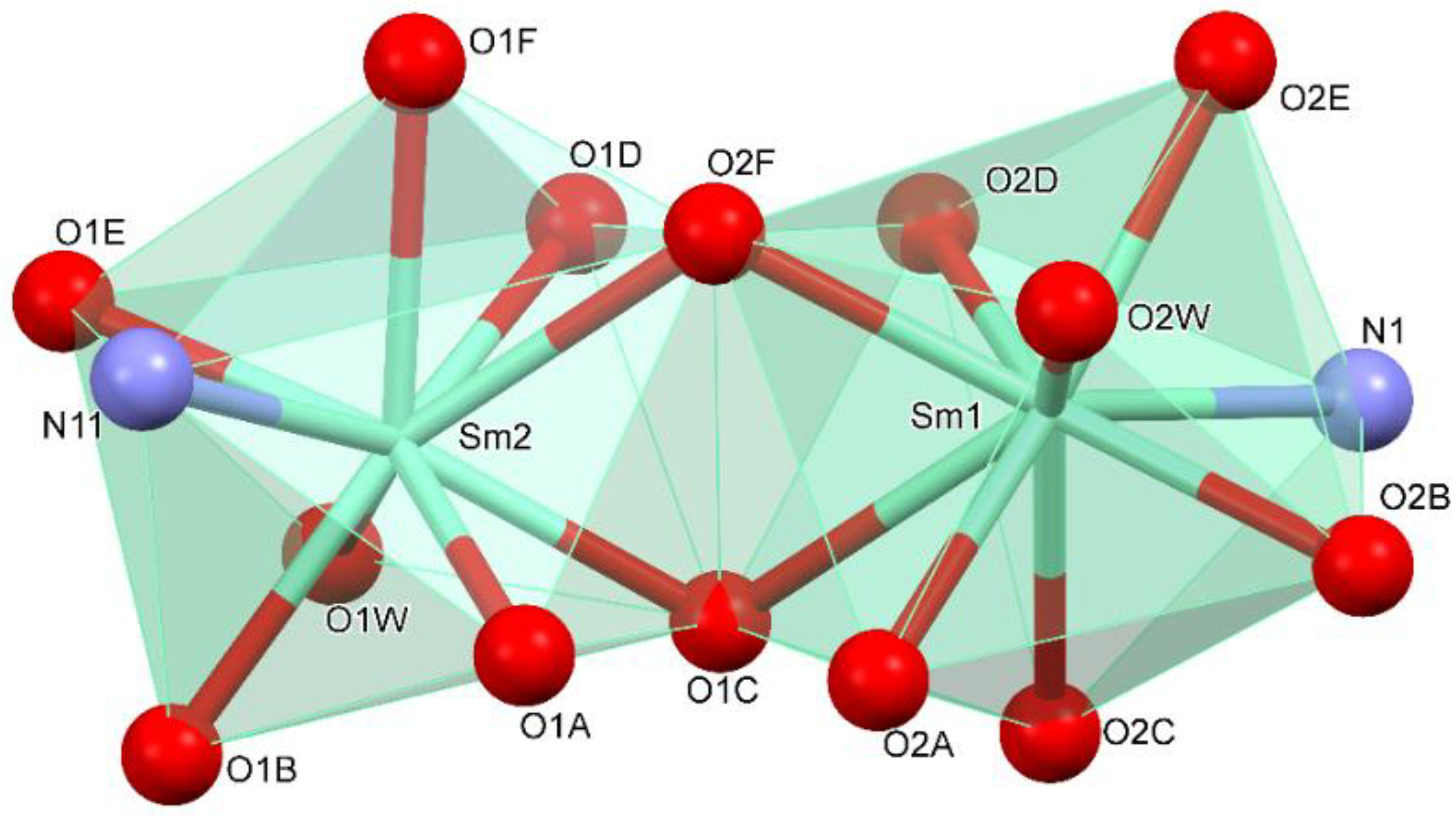
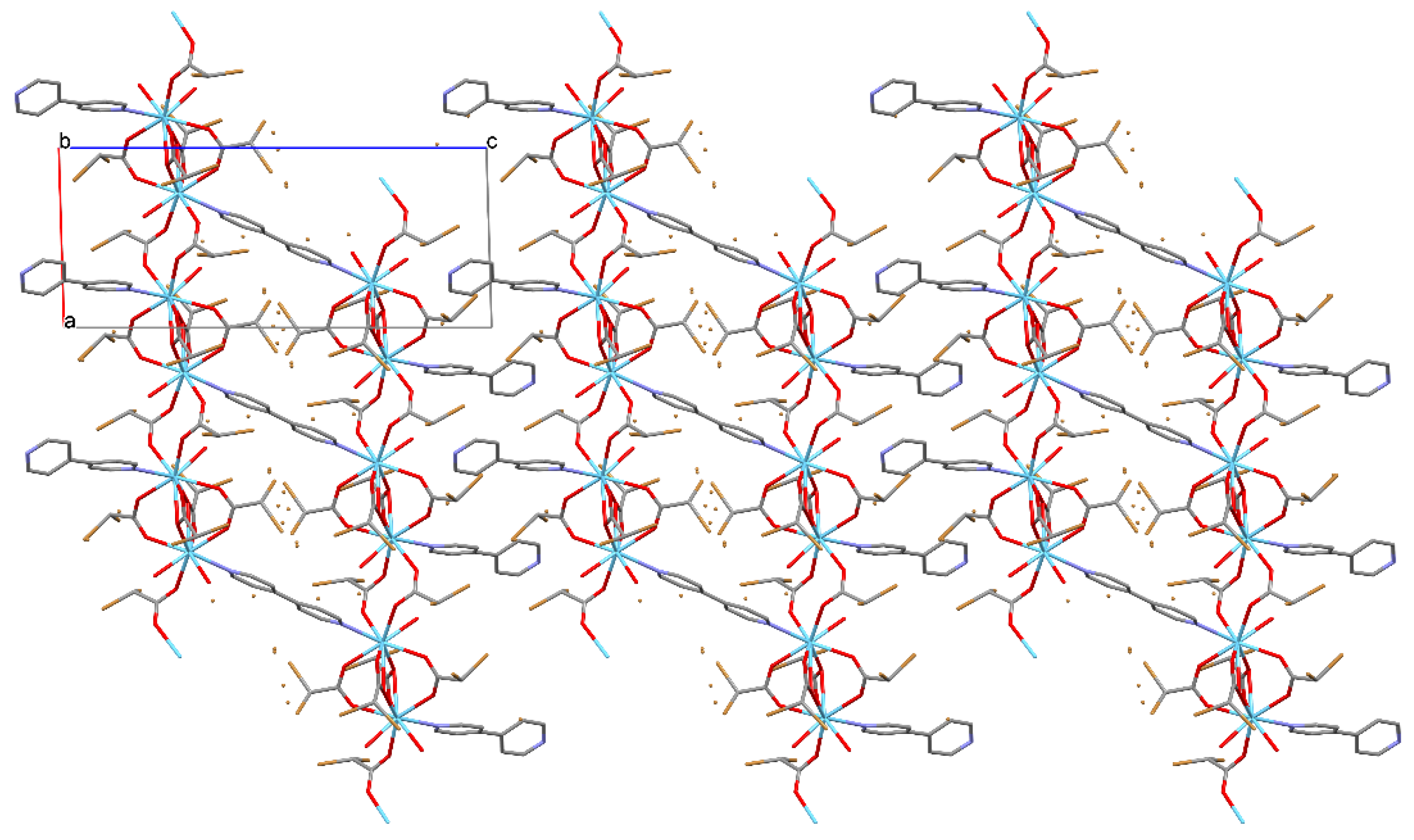
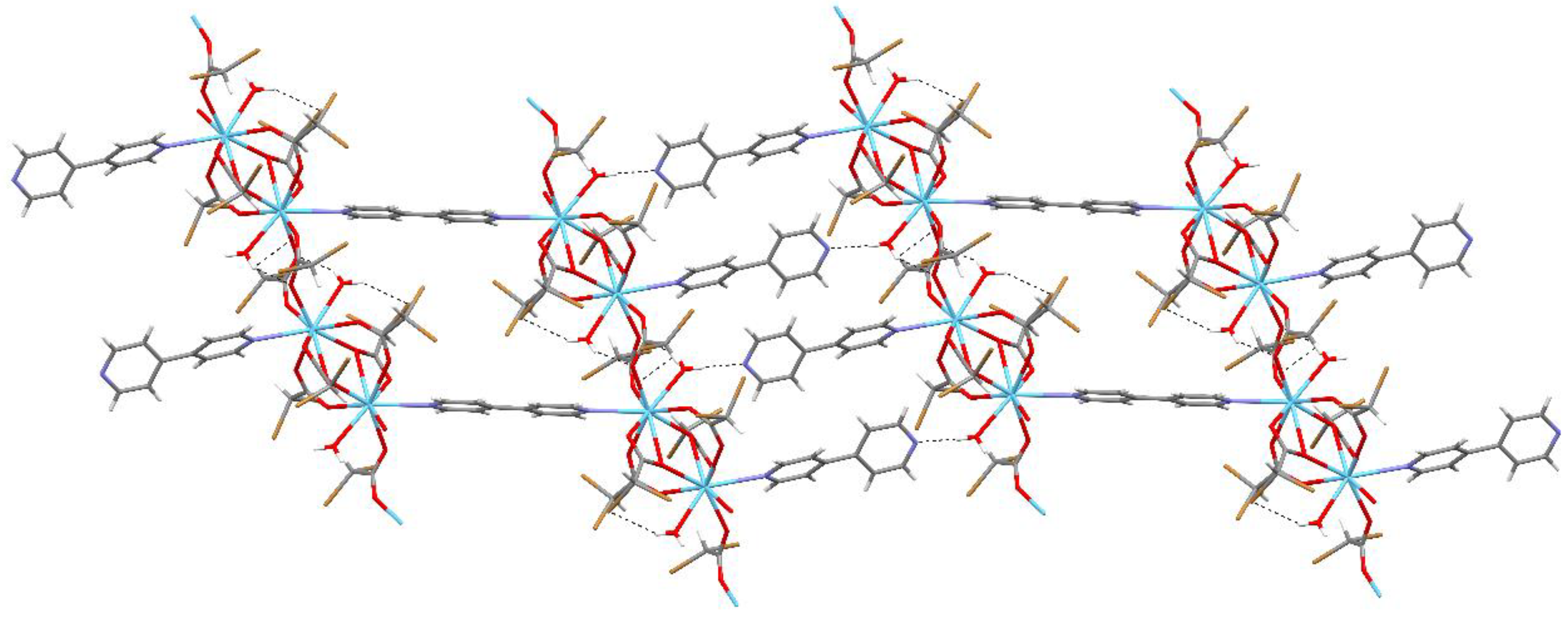


| Compound | Range of Decomposition/°C | Mass Loss/% | Intermediate and Residue Solid Products | |
|---|---|---|---|---|
| Found | Calc. | |||
| La2(4,4′-bpy)1.5(CBr2HCOO)6(H2O)2 | 50–135 | 2.0 | 1.95 | La2(4,4′-bpy)1.5(CBr2HCOO)6 |
| 200–340 | 34.0 | 33.84 | La2(4,4′-bpy)(CBr2HCOO)2Br4 | |
| 340–950 | 47.0 | 46.59 | La2O3 | |
| Sm2(4,4′-bpy)1.5(CBr2HCOO)6(H2O)2 | 50–125 | 2.0 | 1.92 | Sm2(4,4′-bpy)1.5(CBr2HCOO)6 |
| 195–325 | 33.5 | 33.43 | Sm2(4,4′-bpy)(CBr2HCOO)2Br4 | |
| 325–945 | 45.5 | 46.02 | Sm2O3 | |
| Crystal Data | ||
|---|---|---|
| Chemical formula | C27H22Br12N3O14 La2 (1) | C27H22Br12N3O14Sm2 (2) |
| Mr | 1849.21 | 1872.09 |
| Crystal system, space group | Triclinic, P-1 | Triclinic, P-1 |
| Temperature (K) | 296 | 296 |
| a, b, c (Å) | 9.6064 (4), 11.0105 (5), 22.9742 (9) | 9.3646 (3), 11.0114 (4), 22.7802 (8) |
| α, β, γ (°) | 82.468 (4), 87.786 (3), 85.730 (4) | 82.242 (3), 88.230 (3), 86.388 (3) |
| V (Å3) | 2401.33 (18) | 2322.32 (14) |
| Z | 2 | 2 |
| Radiation type | Mo Kα | Mo Kα |
| μ (mm−1) | 11.80 | 12.89 |
| Crystal size (mm) | 0.3 × 0.3 × 0.1 | 0.4 × 0.2 × 0.1 |
| Data Collection | ||
| Diffractometer | Kuma KM-4 CCD | Kuma KM-4 CCD |
| Absorption correction | Multi-scan CrysAlis RED, Oxford Diffraction Ltd., Version 1.171.33.66 (release 28-04-2010 CrysAlis171.NET) (compiled Apr 28 2010,14:27:37) Empirical absorption correction using spherical harmonics, implemented in SCALE3 ABSPACK scaling algorithm. | Multi-scan CrysAlis PRO 1.171.41.76a (Rigaku Oxford Diffraction, 2020) Empirical absorption correction using spherical harmonics, implemented in SCALE3 ABSPACK scaling algorithm. |
| Tmin, Tmax | 0.250, 1.000 | 0.106, 1.000 |
| No. of measured, independent and observed [I > 2σ(I)] reflections | 33071, 8797, 6405 | 32238, 8811, 7090 |
| Rint | 0.034 | 0.053 |
| (sin θ/λ)max (Å−1) | 0.602 | 0.610 |
| Refinement | ||
| R[F2 > 2σ(F2)], wR(F2), S | 0.031, 0.073, 1.00 | 0.047, 0.114, 1.02 |
| No. of reflections | 8797 | 8811 |
| No. of parameters | 609 | 586 |
| No. of restraints | 258 | 234 |
| H-atom treatment | H atoms treated by a mixture of independent and constrained refinement | H atoms treated by a mixture of independent and constrained refinement |
| D—H···A | D—H | H···A | D···A | D—H···A | Symmetry Codes | Graph-Set |
|---|---|---|---|---|---|---|
| O1W—H1WA···Br5C | 0.83 (1) | 2.95 (4) | 3.589 (4) | 135 (5) | R (7) | |
| O1W—H1WB···N1i | 0.84 (1) | 2.84 (7) | 3.231 (6) | 110 (6) | (i) x + 1, y, z | R (8) |
| O1W—H1WB···O2Bi | 0.83 (1) | 2.07 (3) | 2.812 (5) | 147 (5) | (i) x + 1, y, z | R (6) |
| O2W—H2WA···O1Eii | 0.84 (1) | 2.16 (3) | 2.907 (5) | 148 (5) | (ii) x − 1, y, z | R (6) |
| O2W—H2WA···O1B | 0.84 (1) | 2.94 (7) | 3.304 (6) | 109 (6) | R (6) | |
| O2W—H2WB···N20iii | 0.84 (1) | 1.90 (1) | 2.734 (6) | 173 (5) | (iii) −x, −y + 2, −z + 2 | C (22) |
| D—H···A | D—H | H···A | D···A | D—H···A | Symmetry Codes | Graph-Set |
|---|---|---|---|---|---|---|
| O1W—H1WA···Br5C | 0.84 (1) | 2.98 (7) | 3.566 (6) | 129 (8) | R (7) | |
| O1W—H1WB···N1i | 0.84 (1) | 2.49 (5) | 3.164 (8) | 139 (6) | (i) x + 1, y, z | R (8) |
| O1W—H1WB···O2Bi | 0.84 (1) | 2.07 (6) | 2.757 (7) | 138 (8) | (i) x + 1, y, z | R (6) |
| O2W—H2WA···O1B | 0.84 (1) | 2.62 (7) | 3.270 (7) | 135 (8) | R (6) | |
| O2W—H2WA···O1Eii | 0.84 (1) | 2.21 (6) | 2.862 (7) | 135 (7) | (ii) x − 1, y, z | R (6) |
| O2W—H2WB···N20iii | 0.84 (1) | 1.92 (2) | 2.745 (9) | 168 (8) | (iii) −x, −y + 2, −z + 2 | C (22) |
© 2020 by the authors. Licensee MDPI, Basel, Switzerland. This article is an open access article distributed under the terms and conditions of the Creative Commons Attribution (CC BY) license (http://creativecommons.org/licenses/by/4.0/).
Share and Cite
Czylkowska, A.; Pietrzak, A.; Szczesio, M.; Rogalewicz, B.; Wojciechowski, J. Crystal Structures, Hirshfeld Surfaces, and Thermal Study of Isostructural Polymeric Ladders of La(III) and Sm(III) Coordination Compounds with 4,4’-Bipyridine and Dibromoacetates. Materials 2020, 13, 4274. https://doi.org/10.3390/ma13194274
Czylkowska A, Pietrzak A, Szczesio M, Rogalewicz B, Wojciechowski J. Crystal Structures, Hirshfeld Surfaces, and Thermal Study of Isostructural Polymeric Ladders of La(III) and Sm(III) Coordination Compounds with 4,4’-Bipyridine and Dibromoacetates. Materials. 2020; 13(19):4274. https://doi.org/10.3390/ma13194274
Chicago/Turabian StyleCzylkowska, Agnieszka, Anna Pietrzak, Małgorzata Szczesio, Bartłomiej Rogalewicz, and Jakub Wojciechowski. 2020. "Crystal Structures, Hirshfeld Surfaces, and Thermal Study of Isostructural Polymeric Ladders of La(III) and Sm(III) Coordination Compounds with 4,4’-Bipyridine and Dibromoacetates" Materials 13, no. 19: 4274. https://doi.org/10.3390/ma13194274
APA StyleCzylkowska, A., Pietrzak, A., Szczesio, M., Rogalewicz, B., & Wojciechowski, J. (2020). Crystal Structures, Hirshfeld Surfaces, and Thermal Study of Isostructural Polymeric Ladders of La(III) and Sm(III) Coordination Compounds with 4,4’-Bipyridine and Dibromoacetates. Materials, 13(19), 4274. https://doi.org/10.3390/ma13194274






